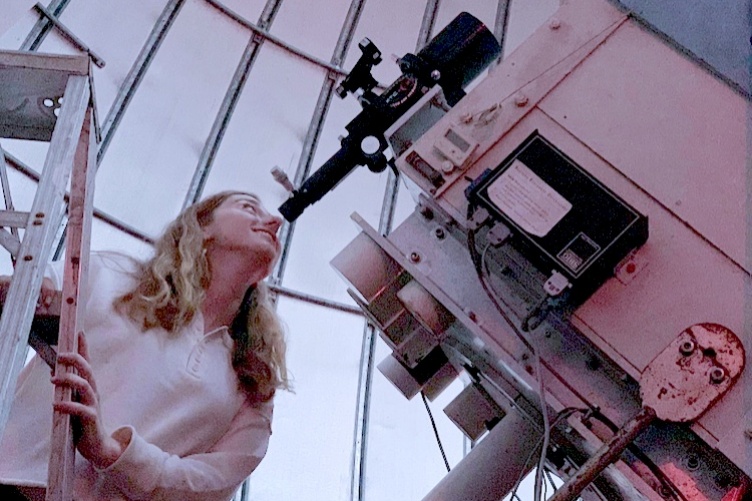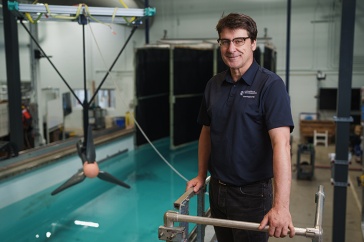
After her first semester at UNH, Morgan Saidel was miserable. It took a course in astronomy for her to realize it was because she had ignored her instincts to reach for the stars.
In high school, Saidel’s wanted to study astrophysics — she had a deep love of space — and pursue a career in research. But people whose opinion she highly respected discouraged her, saying it would be hard to find a job. So she declared neuroscience as her major. Then Intro to Modern Astronomy reset her course.
“After sitting in the class for barely a week I realized I was in the wrong field. I switched my major to physics with a concentration in astronomy and have dedicated my time to astrophysics research and learning more about the field I love,” says Saidel, who will graduate in December. “It might be difficult to achieve a career in this field, but I would never forgive myself if I didn’t try.”
Saidel’s interest in outer space began when she about four years old after watching “Star Wars” with her father.
“I was too young to understand the plot; instead I became enraptured by Luke Skywalker and his merry band of heroes riding speeders on the forest moon of Endor or soaring through the clouds of the gaseous planet Bespin,” she says. “As nerdy as it sounds, because of these movies, I became infatuated with space and astronomy. So, it was this fascination with a galaxy far, far away that initially fostered my love of astronomy.”
That love has been flushed out and reaffirmed through the numerous internships Saidel has completed; two at UNH, one at Cornell University and the one she just completed at Harvard University.
“As nerdy as it sounds, because of these movies, I became infatuated with space and astronomy. So, it was this fascination with a galaxy far, far away that initially fostered my love of astronomy.”
During the summer following her freshman year, Saidel worked with UNH professor Mark McConnell on developing three-dimensional models of gamma radiation detectors. Gamma-ray detectors are used to detect gamma-rays from high energy astrophysical sources such as pulsars or black holes. Her next research project had her studying the variability of the Crab Nebula, a supernova remnant in the constellation of Taurus that emits gamma radiation. Saidel developed programs to analyze the emissions to see if there was a discernable pattern in the fluctuations.
A Research Experience for Undergraduates (REU) grant from the National Science Foundation took her to the Carl Sagan Institute at Cornell where she explored potential Earth-like exoplanets with the James Webb Space Telescope (JWST).
“The JWST is scheduled to launch in 2021. It will be able to detect the atmospheres of a variety of exoplanets, in particular Earth-like, rocky worlds. So, my project was to simulate the detections of Earth-like exoplanet atmospheres with JWST in preparation for its launch,” says Saidel, a Manchester, New Hampshire, native.
A second REU allowed her to conduct research with the Harvard-Smithsonian Center for Astrophysics (CfA) Observatory this summer, studying the development histories of large-scale Martian dust storms. Because of the coronavirus, the internship was done remotely. Saidel notes that there were challenges, particularly not being with the scientists and other interns, which she says felt isolating. But she credits the effort the program coordinators made to bridge the gap.
“They did a great job organizing zoom calls that allowed us to catch up and get to know one another and our research projects,” Saidel says. “They also had us host colloquia given by CfA scientists, which gave us the experience of leading a colloquium, learning about the ongoing research at the CfA and allowing us to connect with CfA scientists, which helped with the COVID isolation blues.”
At Cornell, Saidel ran an open house at the Fuertes Observatory where she taught people about space. She was also involved with the Spacecraft Planetary Imaging Facility, instructing a 4-H workshop on exoplanets for 20 high school students.
Saidel joined UNH’s Students for the Exploration and Development of Space (SEDS) her freshman year, just as the group was starting up. She worked on the development of a nose cone for a high-altitude multistage rocket for a national competition and was SEDS chief outreach officer, designing several lesson plans for community outreach to middle and high schools.
“While I loved my time with SEDS, I found myself more drawn to astronomy research whereas the club was heading more in the direction of aerospace engineering. So, after two years I left the club to devote more of my time to research, and to my job as a tutor at UNH’s Mathematics Center,” she says. “I find teaching and outreach incredibly gratifying and inspiring. To see the excitement on the children’s faces as they learn about the vastness of space, or to see them start to understand the difficult mathematical concepts they are learning is an experience I find incredibly rewarding.”
Saidel plans to pursue a Ph.D., with the goal of working at a research center.
-
Written By:
Jody Record ’95 | Communications and Public Affairs | jody.record@unh.edu

















































